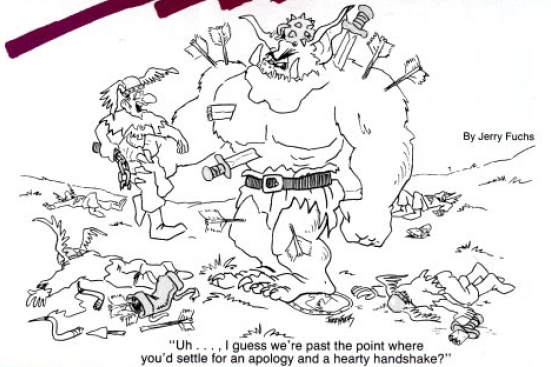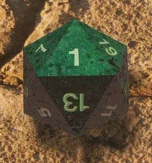The warrior knew he was dead even before the enemy’s steel
bit hungrily into his warm flesh. Only moments before, it was he
who had this creature near death. It was not until he stumbled in
the midst of a fast and frantic exchange of blows that the
thought flashed through his mind — this might be his last fight.
The bright steel that had held a razor-sharp edge through so
many battles now seemed to dull as it connected harshly against
the metallic skin of the creature.
Then sword met sword.
Time stopped as the warrior saw pieces of finely wrought
metal scatter to the four winds, catching flashes of light as they
fell toward the floor.
The creature’s evil blade seemed to hang momentarily in the
air. The split seconds seemed like hours to the doomed warrior,
as his grip instinctive/y tightened on the now-useless hilt. His
muscles tensed in anticipation as he waited bravely for the final
blow to be struck...
The one item usually missing from the aftermath of a good
AD&D battle is the sight of broken
and battered weapons littered
among the freshly hewn corpses. The following tables introduce
this aspect of combat, making recreations of scenes such as the
above possible. However, not all would be as deadly.
Whenever an unmodified 1 is the result of a “to hit” roll, the <alt:
M
- R = F>
following tables should be consulted to determine the adverse
results (if any) of such a terrible throw.
The system is flexible, allowing DMs to introduce
only those tables desired, depending on the level of complexity
and realism sought.
Table 1 can be used on its own, or Table 2 added for more
interest. If both these tables are being used, then Table 3 can
also be optionally included.
Table 1 describes the various mis-chances that could occur in
the heat of battle. For any result, at least 1-4 points of damage
are caused; this number should be modified upward by the DM
to take into account bonuses to damage (such as the “plus” of a
magic weapon) or special circumstances (such as a party
member being hit, causing him to fall into a pit).
“Damage to party member” could be caused by the character
accidentally bumping another party member into a wall, tripping
them, or knocking them off balance (which causes them to
take extra damage from an opponent); or even by a wild swing
with a weapon.
“Damage to self” might occur under similar circumstances to
those mentioned above and would possibly also include such
slips as a distracted magic-user
dropping a dagger through his
(or her) foot.
Damage to a weapon may be the result of a wild swing connecting
with a dungeon wall; trying to bruise an iron golem with
a wooden club; enthusiastically attempting to chip the favorite
boulder of a stone giant; or just old age, from having fought in so
many battles.
Specific types of weapon damage (or lack of it) are given in
Table 2. This aspect can be included so that broken or damaged
weapons (especially magical ones which fail their saving throws)
may later be repaired. It is also possible that the weapon can
continue to be used, at reduced effect, depending on how badly
it is damaged.
Table 3 is used to determine during which round of fighting
the damage to the weapon will occur. This may be a round when
the character fails to score a hit on the opponent, for it must be
remembered that weapon hits will still be occurring on other
weapons, shields, and armor. Such hits cause no damage to the
opponent, but the force of the blow is enough to damage a
weapon. Only a careful examination (which obviously cannot be
carried out in the middle of a melee) by a qualified character will
reveal that the weapon is damaged and will soon break. A qualified
person is one who deals closely with the material involved.
For example, a swordsmith would be qualified to inspect all
types of metal swords and daggers, because he would have a
basic understanding of the metallurgy involved. A player character
who has had previous experience as a smith,
for instance,
could only be a qualified judge if he had followed this trade for a
few years and not just a short period of time.
Roll on these tables if a natural 1 is rolled.
| 01 | Damage to party member; weapon damaged and dropped out of reach. (1.1, 2, 1.4) |
| 02 | Damage to party member; weaponed damaged and dropped within reach. (1.1, 2, 1.3) |
| 03-04 | Damage to party member; weapon undamaged but dropped out of reach. (1.1, 1.4) |
| 05-06 | Damage to party member; weapon undamaged but dropped within reach. (1.1, 1.3) |
| 07-12 | Damage to party member; weapon still held. (1.1) |
| 13-20 | Damage to party member; no effect on weapon. (1.1) |
| 21 | Damage to self; weapon damaged and dropped within reach. (1.2, 2, 1.4) |
| 22-23 | Damage to self; weapon dropped out of reach. (1.2, 2, 1.3) |
| 24-26 | Damage to self; weapon damaged and dropped within reach. (1.2, 1.4) |
| 27-29 | Damage to self; weapon dropped within reach. (1.2, 1.3) |
| 30-38 | Damage to self; weapon damaged but still held. (1.2, 2) |
| 39-50 | Damage to self; no effect on weapon. (1.2) |
| 51-52 | Weapon damaged and dropped out of reach. (2, 1.4) |
| 53-55 | Weapon damaged and dropped within reach. (2, 1.3) |
| 56-60 | Weapon dropped out of reach. (1.4) |
| 61-65 | Weapon dropped within reach. (1.3) |
| 66-80 | Weapon damaged but still held. (2) |
| 81-00 | Nothing unusual happens. |
Notes on Table 1
1.1 "Damage to party member" indicates a member of
the party
of the character, or the monster, who rolled the 1. If the character
or monster is alone or if no other members of the party are within
striking distance, then treat this result as "Damage to self." Weapon
damage will still apply, as appropriate. If more than one party member
is within striking range, determine the member hit by random
selection, remembering to include NPCs.
1.2 "Damage to self" is halved if the character makes a save vs. Rod, Staff, or Wand.
1.3 If a weapon is damaged, roll on Table 2 to determine
specifics.
If Table 2 is not being used, the weapon must save vs. disintegration
or be damaged beyond repair. Magic weapons receive their ususal
saving throw bonuses.
1.4 A "weapon within reach" can be recovered in the
round after
it was dropped. No blow against the attacker is
possible for these two rounds (unless another wewapon is obtained,
of course).
1.5 A "weapon dropped out of reach" can be recovered
in the
second round after it is dropped. No blow against an attacker is
possible for these two rounds (unless another weapon is obtained, of
course).

1.6 If a PC, NPC, or monster is only
using fists, fangs, teeth, claws, and other such body weaponry, they
take 1-4 points of damage in place of a "weapon damaged" result.
Damage taken is halved if a save vs. rod,
staff or wand is made.
This may be in addition to any other damage taken in that round.
| 01-02 | Weapon completely broken; smashed or shattered. (2.4) |
| 03-05 | Weapon damaged; -2 to hit, -50% to damage. (2.5) |
| 06-10 | Weapon partly damaged; -1 to hit, -25% to damage. (2.5) |
| 11-12 | Head of weapon broken off and smashed. (2.2, 2.4) |
| 13-15 | Head of weapon broken off and damaged. (2.2, 2.5, 2.6) |
| 16-20 | Head of weapon broken off, partly damaged. (2.2, 2.5, 2.6) |
| 21-30 | Head of weapon damaged; -50% to damage. (2.2, 2.5, 2.6) |
| 31-45 | Head of weapon partly damaged; -25% to damage. (2.2, 2.5) |
| 46-47 | Tail of weapon broken off and smashed. (2.2, 2.5) |
| 48-50 | Tail of weapon broken off and damaged. (2.3, 2.6, 2.4) |
| 51-55 | Tail of weapon broken off and partly damaged. (2.3, 2.6, 2.5) |
| 56-65 | Tail of weapon damaged; -2 to hit. (2.3, 2.6, 2.5) |
| 66-80 | Tail of weapon partly damaged; -1 to hit. (2.3, 2.5) |
| 81-00 | Weapon undamaged. |
2.1 If weapon has been damaged, roll on table 3 (if
it is being
used) to establish when the damage occurs.
2.2 The "head" of a weapon is that part which inflicts
the damage:
sword blade, arrowhead, tip of lance, head of mace, and so on.
2.3 The "tail" of a weapon is that part which is used
to control
the aim: hilt of sword, longbow, crossbow, rear portion of lance,
handle of mace, and so on.
2.4 Any part of a weapon receiving a "smashed" result
cannot be
repaired or used further. Any remaining undamaged part of the
weapon might be usable at reduced effect, depending on the weapon
and which part of it remains intact (see note 2.6).
2.5 Penalties given by the table for "damaged" and
"partly damaged"
weaponry are cumulative. They take effect in the round after
the weapon was found to be damaged, and continue until the
weapon is either repaired or destroyed.
2.6 Many weapons are unusable when a part has been
damaged
or broken off, but the wide range of possible weapons and possible
circumstances will make it necessary for the DM to rule on whether
certain damaged weapons can be effectively employed. Two
clear-cut examples: The front half of a spear is just a smaller spear,
but the front half of a sword blade is virtually useless as a weapon.
Weapons were designed to be well balanced for maximum striking
effect, and this balance would be affected if part of the weapon were
broken off. For any parts of the weapon that the DM
agrees can be usable in combat, "to hit" and damage penalties must
be worked out. Penalties will depend on the circumstances and the
actual part of the weapon being used.
2.7 If the weapon has not been dropped (as given by
table 1) but a
result on Table 2 indicates "Head of weapon broken off" or "Tail of
weapon broken off," the the head of the weapon will fall to the
ground within reach, and the tail will still be held. A "weapon
dropped" result on Table 1 refers to the entire weapon, whether or
not it was broken or damaged.

TABLE 3: Time of damage to weapon
| 01-10 | Weapon damaged and/or dropped this round. |
| 11-16 | Weapon damaged and/or dropped next round. |
| 17-19 | Weapon damaged and/or dropped in 2 rounds. |
| 20 | Weapon damaged and/or dropped in 3 rounds. |
Note on Table 3
3.1 Damage to PCs, NPCs, and monsters in the melee round in which the
1 was rolled.
Table 3 is only to be used for weapons which are not a natural part
of a creature or character.